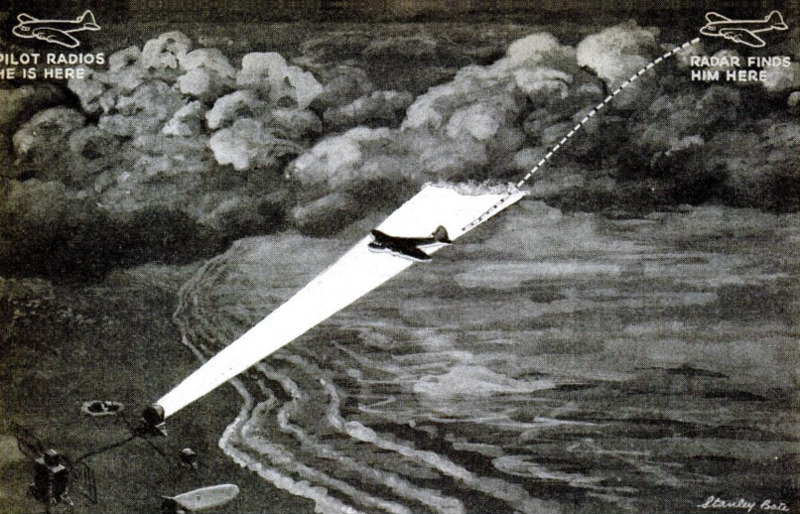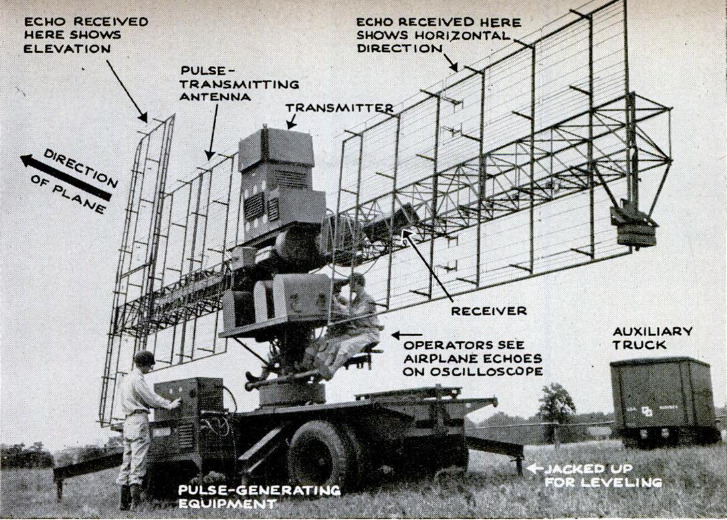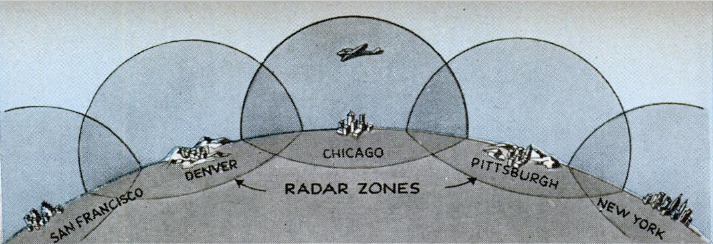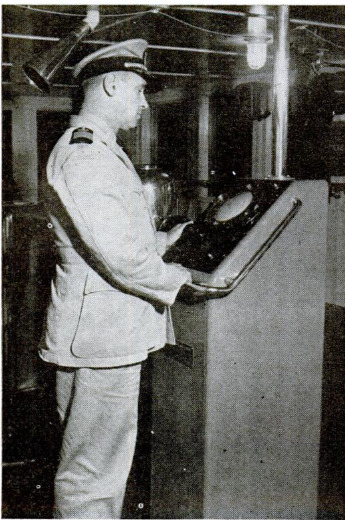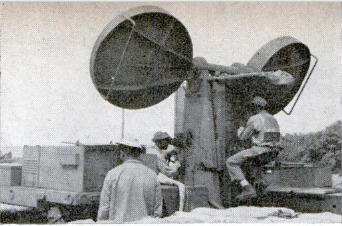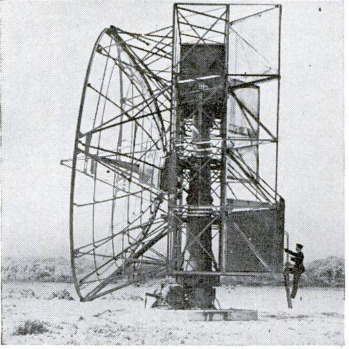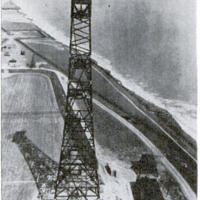-
Title (Dublin Core)
-
How radar will help you?
-
Article Title and/or Image Caption (Dublin Core)
-
Title: How radar will help you?
-
extracted text (Extract Text)
-
THE man-made eyes that secretly aimed
guns and bombs until V-J Day first
proved their peacetime usefulness seven
years ago by leading a lost flyer safely back
to land—and that’s the way radar may soon
serve you. It will give the air lines the
equivalent of the railroads’ signal lights,
semaphores, and automatic block systems.
On a cloudy, windy night in December
1938, less than a year before World War II
- began, a convoy of trucks and strangely
rigged trailers was hooked up to an Army
searchlight in a carefully guarded area near
the mouth of Chesapeake Bay. The equip-
ment was the first service test model of the
Signal Corps Laboratories’ ‘Detector
Against Aircraft, Radio.” From Langley
Field, Virginia, an Army bomber flew
toward the test zone. The pilot's instruc-
tions were to approach from any angle on
the landward side. The job of the radar op-
erators was to find him, track him, light him
up with a searchlight so that antiaircraft
guns could theoretically shoot him down.
In this crucial test, which was to decide
whether listening-horn sound locators were
to become obsolete, the new radio detector
apparently failed. For 45 minutes the an- |
tennas were turned from side to side and
tilted up and down—yet the anxious watch-
ers of the scope could see no signal. High- |
ranking observers, some of them skeptical
about this new gadget that was supposed to
see through clouds, were getting impatient.
The engineers were worried.
Then Dr. Harold Zahl, physicist of the
Signal Corps Laboratories, had an idea. He |
turned to the Coast Artillery liaison officer |
and asked: |
“How about searching toward the sea.
The wind up there—" |
“O.K.,” he said. “Turn her around.”
The operator cranked his handwheel until |
the antenna faced east. |
Almost immediately a “pip” showed on |
the scope—a little inverted “V” formed as |
the trace of the electron beam rose from
the base line to indicate that an echo was |
coming in. Its position at the edge of the |
scope showed that the echo came from an |
object 23 miles away, and the direction of
the antennas showed that the object was |
out over the Atlantic.
Meanwhile, the pilot had been telling the
test officials by radio that he was 20,000 |
feet above Fort Monroe, Va. The radar |
operators radioed the pilot to circle around.
As he did, the echo on the scope bobbed up
and down. The operators then told the
pilot to drop below the clouds for a look.
He found nothing but a vast expanse of
cold, gray water. From then on the pilot
took his instructions from the radar oper-
ators. They navigated him back to shore
by radio, telling him all the time just where
he was.
That was the first known occasion in
America when radar served for air naviga-
tion. Throughout the war, one of radar's
main contributions was in telling airplanes
where they were and when to bomb.
This story illustrates one way by which
radar will “help eliminate the risk from
civilian air travel. Controllers at ground
radar sets at airports and other key loca-
tions along the airways will tell at a glance
the direction, altitude, and distance of all
aircraft within their zone of coverage. This
is likely to be the first application of radar
to air travel, since ground sets of this type
are in production and a number may be
disposed of as surplus by the armed serv-
ices. An immediate advantage of this kind
of flight control is that a comparatively
small number of stations on the ground
can cover an entire airway, and no special
equipment in the airplane is required.
There are many other ways in which
radar will help. They depend on its two
great virtues—measuring the exact distance
of a remote object and determining the
object's direction. In many applications,
both features are used. In other applica-
tions, the measurement of distance alone is
sufficient, since if the distance to two or
more known objects is determined accurate-
ly, the position of the airplane can always
be picked out on a chart by triangulation.
Radar measures distance by timing the
period between the sending of a pulse and
the reception of its echo—and does this
with great precision.
To appreciate just what radar can do for
air travel in the near future we must realize
its limitations as well as its dramatic
capabilities. Radar is not television, al-
though the two have many things in com-
mon. In television you need good enough
visibility at the sending end to impress a
picture on the iconoscope. The whole mov-
ing picture is transmitted as it happens by
radio, but it only makes a one-way trip.
In radar, on the other hand, a round trip
is always involved. You send out a brief
pulse of radio waves; if they hit a solid
object, a faint echo comes back. Television
transmits what the eye can see. Radar
records things the eye cannot see. Radar
does things that television cannot do—it
sees through fog, smoke, clouds, and dark-
ness. Television does things that radar
cannot do—it gives you the actual details
of the picture, whereas radar only gets an
indication that must be interpreted before
it can be used.
Radar has contributed greatly to the
perfection of television through the develop-
ment of components used in both. For
instance, the favorite indicator in radar is
the scope—the cathode-ray oscilloscope—
which is very similar to the viewing screen
of a television receiver. Scopes have been
tremendously improved as the result of
radar’s needs, and the consequence will be
clearer television pictures.
Again, the receiver which amplifies the
faint echo of radar must be of “video”
quality, that is, it must build up the pulse
to a usable strength without distorting its
shape. Television engineers struggled for
years with “video” amplifiers that would
present a true picture to human vision.
Radar engineers borrowed that technique
and perfected it. Thus the $2,700,000.000
United States investment in radar will be
reflected to the public in better television.
The investment in radar will also safe-
guard our airways. But we might as well
be realistic about it. The superlative mili-
tary precision instruments that weigh
hundreds of pounds and cost from $10,000
up aren't going to be issued as accessories
With every fiivver plane. There will have
to be a lot of adapting, simplifying, and
cheapening. Fortunately, for purposes of
safe navigation in a peacetime world, many
of the costly complications of military
radar aren't needed at all
There has been a lot of discussion of the
‘Mickey radar used by bombing planes to
search the sea for ships and submarines
and to pick out such ground targets as
cities. With “Mickey” the pilot can see on
the scope a maplike presentation of rivers,
coastlines, and built-up areas. This kind of
radar was used in the night and bad-
weather bombing of Germany and Japan.
However, even with all the funda and
priorities given to radar by the Army and
Navy, it was never possible during the war
to equip all bombing planes with “Mickey.”
For a long time the practice was to have
only one plane in a squadron so equipped,
serving as a “pathfinder,” and it dropped
the first bombs or smoke indicators. The
other planes then dropped thelr bombs in
the area designated by smoke, fire, flares,
or explosions. Eventually, this “Mickey”
radar may be simplified and adapted for
cheap mass production, but not now.
However, we can still have good radar
navigation very soon. What does seem
very probable in the near future is that
commercial and private airplanes will be
equipped with auxiliary radar equipment
to work in conjunction with a system of
powerful radar stations on the ground. This
will be a contribution from the wartime
‘system known as “IFF’—identification,
friend or foe. Originally designed to distin-
guish a friendly plane from an enemy on
the radar scope, IFF has since developed
into a navigation system using “racons’—
radar beacons.
In this system a receiver is tuned to the
wave length of a transmitter on the ground.
It is hooked up to its own small transmit-
ter, also on the airplane. The combination
is known as a transponder—it transmits a
response, acting like a radio relay except
that it puts its own identifying stamp on
the amplified response. But it does more
than identify. When the airplane has a
transponder, the range of the ground radar
on friendly airplanes is greatly increased.
Thus, in the world of peacetime commerce,
in which all commercial planes will be
“friendly, it will not be necessary to equip
an airplane with its own complete radar set.
All that will be necessary will be a trans-
ponder. In this way the ground radar sta-
tions can keep check on airplanes over a
large area and tell them where they are by
radio.
‘When a transponder is mounted at a fixed
position on the ground it is known as a
racon (radar beacon). Here, instead of
having a ground radar station send out a
pulse to which the airplane responds, the
system is reversed. At various points on
the ground, transponders are set up. Each
one, when it receives an interrogating pulse
from an airplane, sends its answer in a
particular combination of radio pulses. Each
ground radar beacon has its own set of
signals which identify it positively, just as
every lighthouse along the coast and every
lightship anchored in a shoal area has its
own special color combination and sequence
of blinking the lights on and off. In fact, it
is quite reasonable that all lighthouses will
eventually be equipped with automatic radar
beacons to respond to interrogation from
ships. This would make them operative in
the worst fog, when present-day lighthouses
lose their vaiue.
The method of finding your position with
radar beacons is a little different from the
triangulation used by surveyors, although
it is based on the same simple geometry.
In ordinary triangulation you get two di-
rectional bearings from the point to be
located, draw those directional lines on a
map—and where they cross is where you
are. In the radar-pulse method you get
the distances from two known beacons and
use each one as the radius for a circular arc
that can be drawn on the map with a com-
pass. Where the two circles intersect is
where you are. The measurement of dis-
tance by even small portable radars is so
accurate that
there is no reason why this system should
not be used also by land surveyors, par-
ticularly in rough, unexplored country
where it may be difficult to set up a transit
or measure a base line with rods and chains.
One requisite for safe aerial navigation
is a knowledge of the plane's altitude above
the nearest terrain. For this there is a
working answer in the “absolute altimeter,”
a simple Kind of radar that projects its
:res downward and measures the time
too. for their return from the nearest
ground. Another safety problem—preven-
tion of collisions with other airplanes—can
be solved by adapting one kind of radar
used by combat planes. Also used in the
war was a small and simple radar known as
TW—for “tail warning”—which is placed
in the tail assembly and rings a bell to
warn the pilot if another plane is approach-
ing from the rear. Turn one of the “tail
warnings” around and have it face forward
from the nose or a wing of the plane. Then,
as you flew blind through a cloud, a bell
would ring if you were coming within range
of collision with another plane, or if a tall
‘structure happened to be fn the way:
Everything that has been said about air-
plane safety and navigation applies also to
surface vessels, except that ship navigation
by radar is easier for two reasons: first, be-
cause the ships move so much more slowly;
and second, because altitude finding is out
of the picture, since ships are always at sea
level. Besides, ships can mount heavier
equipment, such as search radars that will
show coastlines, projecting rocks and reefs,
harbor buoys, icebergs, and other ships.
Eventually, as radar systems are greatly
simplified, some adaptation of the interroga-
tor-beacon system might be used to pre-
vent collisions of automobiles and railroad
trains. For instance, for use in fog, every
automobile and train might some day be re-
quired to have an interrogator installed
alongside its headlights and transponders
installed both front and rear. Thus there
would always be warning against either a
rear-end or a head-on collision. But this
is not likely to be a thing for today or to-
morrow. Radar equipment will have to be-
come a lot cheaper before we can expect its
installation to be required by the various
state motor vehicle bureaus. At any rate,
some such system appears much more prac-
tical for the foreseeable future than the wild
ideas voiced in some quarters about having
a televisionlike screen in your car that
would show every fence post ahead.
-
Contributor (Dublin Core)
-
Harry M. Davis
-
Language (Dublin Core)
-
Eng
-
Date Issued (Dublin Core)
-
1945-10
-
pages (Bibliographic Ontology)
-
84-87,234
-
Rights (Dublin Core)
-
Public domain
-
Archived by (Dublin Core)
-
Sami Akbiyik
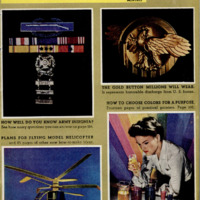 Popular Science Monthly, v. 147, n. 4, 1945
Popular Science Monthly, v. 147, n. 4, 1945

